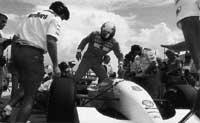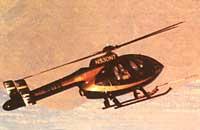Night helmet for pilots
1991/04/01 Otaolaurretxi, Jon Iturria: Elhuyar aldizkaria
Once the Cold War between West and East is over and the experience of the Near East Hot War is known closely, it seems that the number of soldiers and materials from different armies will improve with quality. The technical offices of the arms industries will have unlimited work, generating and applying technological advances. This has happened at least to those who are developing a screen helmet for pilots to work at night for warplanes and helicopters.
Helmet with screen
When preparing the helmet for use, it is clear that wars will not be the same as before, as at night they will act as during the day. The person, however, is not the one who sees in himself the Niktalope or the night, and that blindness of darkness must disappear artificially.
Another problem is how to inform the pilot. The person must be informed, assimilated and act accordingly. The helicopter pilot, for example, lights up with red light in the air and starts to sound an alarm for detecting anti-aircraft cannons on the ground. The pilot must then perform his calculations to know if these cannons are up to his path. The information thus provided is therefore not effective because the pilot needs a lot of time to make decisions. But if you are applied impressed on the view of the road that will perform the information, the pilot will not waste time interpreting the signal.
This type of synthetic presentation is currently used frequently in commercial aircraft. As the display screens began to be placed, pilots can see on the same screen the route of the plane, the future and the weather. The information provided by the radar screen to know whether or not we are going to enter a storm zone requires no calculations and decisions can be made before.
At present, in the military sphere the pilot screen is intended to be placed in its own helmet and in it are, among others, the following houses: GEC Avionics in Great Britain, Sextanto Avionique in France, Elbite in Israel and Honeywell and Kaiser Electronics in North America. They all have common goals, but they are based on very different technologies. It is, in short, to be located in the helmet of the pilot screen, but for this purpose experts in different fields of science collaborate: optical, electronic, mechanical, psychologists, physiologists and ergonomic.
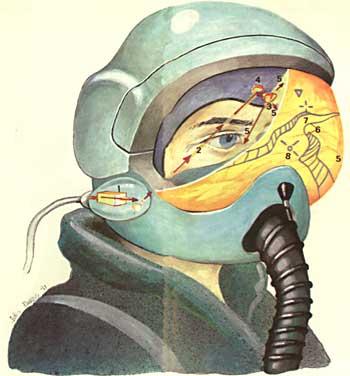
Helmet targets with screen
For those who want to create a viewing helmet, the objective is triple: to be able to see it at night, to facilitate aerial navigation and to point to eye.
To see it at night you would be given the images taken by the optronic sensors, infrared sensors or television cameras that improve the light intensity.
To facilitate aerial navigation, other synthetic figures (lines) are projected onto the landscape images that allow the pilot to carry the plane through the roads or tunnels, location of the antiaircraft cannons or missiles of the enemy, etc. is displayed. The potentially dangerous positions of enemies will appear on the screen in the form of a globit. Their size and volume will depend on the risk. In any case, the pilot will never access the area of these volumes due to the risk of death.
In order to visually target the weapons, the pilot will be able to mark an air or land target to the missile guidance system by moving his eyes and he will automatically prepare to reach the assigned point.
In France the house Sextanto Avionique began to investigate this helmet about twenty years ago and it seems that the first model will be taken out in 1995, together with the Tiger war helicopter, which the French, British and Germans want to pull together.
In general, all screen helmets currently being developed are similar. The differences are due to the way each detects the mental movement of the pilot.
Hull structure
Depending on the structure of the helmet, two main parts are distinguished: the frame and the optical part. The frame has attached visor. Its mission is to protect the pilot from blinding laser rays of enemies. The frame weighs 1.6 kilos in total. As for the optical aspect, you want to get a maximum of 0.6 kilos. Thus, the total weight of helmets would be 2.2 kilos. The helmet is usually used by the pilot for two or three hours and it is convenient that it is light on one side and that the center of gravity of the helmet matches the center of gravity of the head. The helmet must be perfectly fixed on the head.
How to supply images
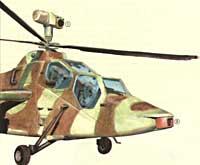
The images that appear on the helmet come in two ways, as indicated above. The images of the landscape are emitted by thermal sensors (infrared) and light intensification cameras (low-light television cameras). The former are normally placed outside the cabin (at the end of the helicopter or on the rotor shaft) because they are too heavy for placement in the hull itself. The second, both on the outside and on the helmet itself (in front of the ears on each side). The second way of providing images is the symbol creator. Its function is to produce synthetic images and superimpress them in landscape images.
Low-light TV cameras for landscape imaging present barriers. It does not detect hidden risks, such as the foot soldier with missiles or the battery of cannons hidden in the forest. In this case, therefore, the use of infrared sensors is recommended. However, the images obtained with the TV camera are better, because we are more used to seeing the landscape as well.
However, the most important thing is that both one system and another are images at 1/1 scale. The images must be presented without deformation and as the pilot's eye normally sees. If you want to see a specific point of landscape on a larger scale, you can logically change scale, but the decision to perform this operation is the pilot himself.
Hull operation
Let's indicate how the helmet works. The images collected in the external sensors are taken to a mini cathodic ray tube inside the first helmet. Subsequently, the images are taken to two opposite tabs of the pilot. This language is a very advanced optical system. It acts as a waveguide and inside are images and symbols coming from the symbol creator before the immediate eye. At present the pilot sees a single color image (yellow-green), but from now on they will develop a color image.
The preparers of the Tigre War Helicopter hope to get a new case for the year 2005. In this model the images will not be seen in two optical tabs, but in a panoramic screen. This visor will be made with very elaborate and fragile optical material, so there will be another that supports protection shocks. Nobody explains how the images will arrive from the cathodic minitubo to the screen, but it could be thought that the rays will be reflected in a front mirror and that later they will come back to the screen reflected in another mirror located on the nose in the forehead.
The problem is the shape of the same visor. At present it is very simple to present images on a flat screen, but it is not so easy to show images on the concave screen without deforming. For this purpose the visor must be parabolic and the ray emitter must be in the focus of the parable.
Images and head movement
So far, it has been more or less overcoming optical problems, but if you really want to get a useful helmet, it is necessary to adapt to the movements of the pilot's head; when the pilot turns his head to the left, you have to give him images that would look without helmet. It can be said that the head turns to the left and looks with the eyes to the right, but the normal thing is from one side to the other. For the moment, therefore, systems will be developed that take into account the movement of the head and subsequently the procedures that are accepted to the movement of the eyes will be studied.
The pilot will have real images and synthetic images in front of him. Knowing the position and direction of the helicopter to offer real images is not so important, as the essential thing is the direction in which the pilot is looking. But to offer synthetic images, in addition to the position and direction of the helicopter, posture (inclined, descending, etc.) is essential. and its altitude. It is symbol creator, as it will choose an appropriate perspective to present the image and image.
Due to the agreement between the observed direction and the image presented, much has been discussed about pointing guns or missiles directly to the target seen by the pilot's eye. In the helmets that are now being investigated (in some way in the first generation), the pilot will have in his visual field a small mark (square, circle or triangle). When the target is seen, the pilot must bring this mark to the target level. In this way, the helmet will be affected by a movement that will serve to orient the cannons or to shoot to drive the missiles.
How to detect helmet position
The second generation cases will direct their missiles to the target with a single look of the pilot. In the meantime, let's see how the movements of the helmet (hence the pilot's head) are detected. The three most commonly used techniques are electromagnetic detection, electro-optical detection and ultrasonic detection.
Electromagnetic detection
is the most used among researchers of this type of helmets. There are two basic elements of operation: the electromagnetic emitter of three orthogonal coils located in the cabin in specific position with respect to the axes of the helicopter and the receiver fixed in the hull (also formed by three orthogonal coils). The reason for having three coils is to be able to place the direction in a three-dimensional space. The transmitter coils send a signal and on each receiver coil induce the magnetic field. When the helmet is standing, the induced area is constant and variable when moving. The measurement of these changes allows to calculate the orientation of the pilot and depending on it, take and present the part of the landscape that should be offered to the pilot. If the pilot moves his head quickly, the landscape also changes quickly and if he turns slowly the change of images also occurs slowly.
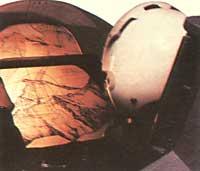
Electro-optical detection:
Electroluminescent diodes are used in helmet and CCD bars ( Charged Couple Device) scattered in cabin. The bars receive the light emitted by the helmet and have different response depending on the light coming from front or side to side.
In another model of the electro-optical system, a camera, once the movements of the head are filmed, sends information to the elements that supply the images.
The electro-optical system has advantages over the electromagnetic if the plane accidentally enters another electromagnetic field, but the helmet must be clarified and this can be beneficial for the enemy.
Ultrasonic detection:
from the helmet are emitted ultrasound and in the cabin there are scattered receivers. Between the emission of the ultrasound and the reception of the receptors there is a certain time. Knowing the speed of sound and measuring time very precisely, it is easy to locate the emitting point of the helmet. Once the position of the different emitters is known, the position of the helmet can be calculated.
You can also calculate the speed of rotation or displacement of the helmet. For this it is necessary to derive (mathematically derived) the variation of the distances with respect to time. Once this data is sent to the image providers, the corresponding landscape will be presented to the pilot.
The main disadvantage of this system is that the speed of sound varies depending on the temperature. Therefore, it is necessary to always use a corrective factor in calculations for this phenomenon.

Gai honi buruzko eduki gehiago
Elhuyarrek garatutako teknologia




